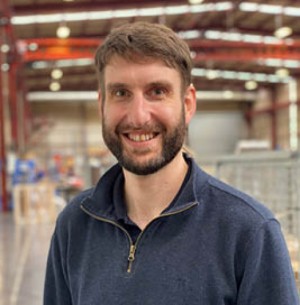Mixed Reality: The Smart Manufacturing Technology You Didn’t Know You Needed
Microsoft’s HoloLens is a break-through mixed reality technology which has the potential to increase efficiencies of operator training and on-site commissioning of manufacturing equipment. The travel restrictions in place during 2020-2021 forced Facteon to adapt its approach to machinery commissioning. Prior to the COVID-19 pandemic, Facteon would send a team of commissioning engineers and machine builders alongside the project manager to a customer’s site to complete machine commissioning.
For many businesses, the COVID-19 pandemic forced them to regroup and adapt to continue delivering for their customers. For a business, such as Facteon, which historically relied on putting our experts on planes to share their knowledge with the customer on-site, the pandemic was an exercise in challenging business norms.
Here, I’ll reflect on how Microsoft’s HoloLens technology has supported us and the manufacturers we work with to continue delivering in unprecedented times.
Providing Certainty During Uncertain Times
As a business, Facteon was fortunate to be working with manufacturers willing to speak openly regarding the impact of the pandemic on their business. The HoloLens technology has allowed us to provide not only manufacturers, but our own internal teams, with the certainty that we will be able to deliver each project as planned. For manufacturers needing to scale up and meet market demand, certainty that their project will be delivered on time and to specification is critical.
Typically, remote support is limited to emails with images attached or phone calls. The capability of the HoloLens bridges the distance between remote support teams and manufacturers. The downtime and frustration caused by awaiting responses are eliminated as HoloLens enables real-time visual communication.
As manufacturing technologies evolve, the skills of workers must also evolve. The HoloLens provides an opportunity to train maintenance staff on the machinery they will be working with in the future. It is also possible to reduce the risk of human error during the learning phase when adapting to a new technology in the facility. Maintenance staff can interact with the machinery in a mixed reality world. Furthermore, the user has schematics in view while working with the machinery. This ensures a fully immersive experience in which operators can make mistakes without potentially contributing to wastage of raw materials or wear caused by improper maintenance practices.
Mixed reality technologies also ensure the safety of manufacturing staff. Rather than employees completing training by performing maintenance on the equipment, they can interact with aspects of the machinery in a virtual world. This ensures workers fully understand the machinery maintenance process prior to applying these skills to the real-world machine.
Delivering Support From Anywhere
With HoloLens technology, on-site technicians are provided with the support they need when building and re-commissioning the machinery. The support is provided by those who designed and built the equipment here in New Zealand. So, the ability to tap into this resource remotely is proving effective. One of the technicians on-site said: “It’s like having an expert on my shoulder”. The ability to see through the eyes of the operator allows for a level of collaboration which is proving invaluable during fault finding exercises.
Planning Machinery Modifications
Mixed reality technology gives us the ability to draw directly on the machine. This can be used to mark out where it will be positioned on the factory floor or sketching out machine modifications. As remote support, we are also able to interact with the real environment. For example, I could circle an element of the machine which needs to be adjusted by the operator. I can even sketch the adjustment instructions directly on the machine. This level of collaboration was previously only possible with in-person visits.
On a larger scale, mixed reality technology allows workers to experiment with an entirely new factory layout. Workers can map out their facility using mixed reality technology. This is particularly useful if a manufacturer is looking to reposition existing machinery. Often times, crucial yet obvious elements can be overlooked, such as cabling, ducts and space between machines for human operators to safely move. By mapping the machinery layout within the real factory environment, manufacturers can have confidence in the suitability of their revised factory floor plan.
Final Thoughts
As manufacturers continue looking for incremental improvements across their facilities, the availability of new technologies, such as Microsoft's HoloLens, have facilitated more efficient ways of operating. Whether these adjustments were made out of necessity to ensure continued operation during the COVID-19 pandemic or if they were a decisive act of business change, manufacturers should consider the key learnings and the continued role of such systems at their facilities. The pandemic caused many manufacturers to reassess their operations. We should not let the opportunities for improvements that have been identified go to waste.
Customer Stories: Remote Installation Managed During The COVID-19 Pandemic
The Facteon team managed the installation of a custom production line in a state-of-the-art facility in the USA. Due to international travel restrictions, the installation was completed with select Facteon personnel based on the customer’s site supported by in-market installation teams.
While the installation took place in the USA, the Facteon team supported from New Zealand. The customer’s team also was involved throughout the installation process. Microsoft’s HoloLens technology allowed Facteon to install a complex production line with minimal delay for the customer while keeping the Facteon team safe.
